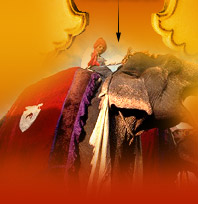Mathura
is the place where Krishna was born in a prison cell. Krishna's parents
are said to have been imprisoned here. Located at Katra Keshav Deo, the
temple is thronged by pilgrims from all over the world. The Dwarkadesh
Temple, built by Seth Gokul Das of Gwalior in 1814, is situated in the
heart of the city. It has some very fine paintings all along the walls
depicting the entire life of Krishna. The Vishram Ghat on the bank of
Yamuna is where Krishna rested after killing Kansa. Being a part of the
Gangetic plain, Vrindavan faces extreme climate with hot and humid
summer and chilly winter. The maximum temperature during the summer can
reach a high of around 45°C and a low of around 5°C during the
winters. Monsoon reaches this region in the first week of July and
continues till the second week of September. The ideal season to visit
Vrindavan is during winters (October to mid-March).
Celebrations
are, in fact, a way of life in Vrindavan. Any occasion is a time to
celebrate and remember the name of God. Chanting of the names of Radha
and Krishna, dancing, singing, etc., are the ways that are considered to
take a devotee from this physical world to the heavenly abode.
Janmashtami in the months of July/August is celebrated as the birthday
of Lord Krishna and thousands of devotees throng the place from all over
the country. Holi is also celebrated with as much enthusiasm. Almost
everyday there is a festival in Vrindavan, but the major ones include
Govardhan Puja, Guru Poornima, Holi, Govardhan Puja, Jhulan Yatra (swing
festival), Radhashtami, and Basant Panchami.
Vrindavan is said
to be one of the most sacred Hindu pilgrimage where there are temples
dedicated to Gopinath, Madanmohan and Gobinda. After worshipping Lord
Gobinda Gopinath, Madanmohan and the other deities are worshipped.
Vrindavan is another pilgrimage filled with memories of the activities
of Sri Krishna. Since a major part of Lord Gobinda Krishna's youth was
spent in Vrindavan therefore Vrindavan bears witness to his innumerable
antics like the meetings with his lady-love Sri Radha, the proposals of
love to the Gopis (milkmaids) and the concealing of the Gopis clothes,
while they were busy bathing in the river Jamuna.
There are
more than 4000 temples in Vrindavan in memory of Sri Krishna and his
innumerable antics and activities. The etymology of Vrindavan comes from
Vrinda-the expert (daughter of King Keder of the Satyayug, according to
Brahmabaibarta Purana) in the sciences of meditation and Yoga shastras,
who chose this place for meditation. According to a 2nd opinion, the
name Vrindavan comes from Brinda meaning Tulsi referring to a Tulsi
thicket (Tulsi Van).
Best time to visitBeing a
part of the Gangetic plain, Vrindavan faces extreme climate with hot and
humid summer and chilly winter. The maximum temperature during the
summer can reach a high of around 45°C and a low of around 5°C
during the winters. Monsoon reaches this region in the first week of
July and continues till the second week of September. The ideal season
to visit Vrindavan is during winters (October to mid-March).
How
to reach
- By Air
The nearest airport is at Kheria in Agra, 62
km from Mathura.
- By Rail
There are a number of tourist coaches from
Delhi leaving for Mathura and Vrindavan everyday. Mathura is 57 km
from Agra and 141 km from Delhi. It is an important railway junction
with direct trains to many places. The Taj Express from Delhi is a
good option.
- By Road
Mathura is well connected by road to Delhi
and other cities of Uttar Pradesh, Madhya Pradesh, Rajasthan and
Haryana.




